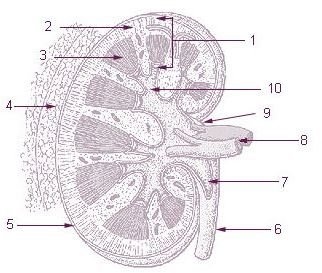Fluid Absorption into Tissues in Peritoneal Dialysis: Causes and Consequences
Peritoneal dialysis is a form of renal replacement therapy based on fluid exchanges using the principle of diffusion. While the traditional peritoneal dialysis techniques often resulted in under-dialysis, development of Continuous Ambulatory Peritoneal Dialysis (CAPD) and its variants have made the fluid exchange process easier, simpler, and faster.
Fluid absorption into tissues in peritoneal dialysis is a side effect of the process.
Image Credit: Wikimedia Commons
The Process
In diffusion, a substance flows from the side of greater to lesser concentration through the membrane, with the relative concentration on each side of the membrane determining the direction of movement of solute.
In peritoneal dialysis, peritoneum, the natural lining of the abdomen finds use as the exchange membrane, and water and dissolved substances or solutes travel across this semi-permeable membrane.
The process entails filling the patient’s abdomen or body cavity with dialysate, a specially designed dialysis fluid consisting of electrolytes and dextrose. The dextrose, or sugar, in the dialysate draws water through osmosis from the body into the peritoneal space. The body tissues absorb some of the dextrose by reverse diffusion. This reduction of the concentration of dextrose within the abdomen, combined with the accumulated concentrates of the waste products that diffuse from the patient’s blood across the peritoneal tissue into the peritoneal fluid stops the process. The dialysate then requires replacement for further diffusion to take place.
Fluid Absorption into Tissues
Recent research validate that the tissues surrounding the peritoneal cavity absorb fluids. This process of water re-absorption from the peritoneal cavity substantially decreases the net ultra-filtration in patients on peritoneal dialysis.
The amount of dextrose absorbed by the body tissues depend on the concentration of dextrose, and on the number of exchanges per day.
The absorption of fluids by tissues has many consequences:
- The absorption of sugar directly increases number of calories ingested, leading to weight gain. Most patients under peritoneal dialysis gain weight due to this reason, and require diet modifications to reduce both weight and the need to lessen fluid removal.
- The continuous absorption by dialysis fluid by tissues increases cholesterol and triglycerides levels in the patients, putting them at increased risk for cardiovascular complications, and even life threatening complications such as swelling in the lungs, or pulmonary edema.
- One positive effect of fluid absorption into tissues in peritoneal dialysis is the possibility of additional supply of glucose via this method during treatment of patients with diabetic nephropathy.
Peritoneal dialysis requires draining the water out of the abdomen after a few hours, when the diffusion no longer takes place. Failure to do could lead to reverse diffusion where the impurities that have higher concentration seep back into the tissues through the peritoneum. This could result in infusion of toxic impurities to the blood.
Peritoneal dialysis, especially CAPD is a simple and safe technique, and a valuable adjunct to the treatment of people with chronic kidney failure. The fluid absorption into tissues is a side effect of peritoneal dialysis, and a control and good attention prevents any harm owing to this condition.
Reference
- Alfred, Howard J. What is Peritoneal Dialysis. Michigan Institute of Technology. Retrieved from https://msl1.mit.edu/esd10/kidneys/hndbkhtml/ch4.htm
- Quellhorst, Eduard. Peritoneal Dialysis. Journal of American Society of Nephrology 13:S92-S96, 2002. Retrieved from https://jasn.asnjournals.org/cgi/content/full/13/suppl_1/S92
- Mayo Clinic. Peritoneal dialysis. Retrieved from https://www.mayoclinic.com/health/peritoneal-dialysis/MY00282/DSECTION=risks
